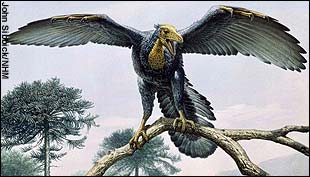- Scientists have finally solved the long-standing riddle
over whether Archaeopteryx, the earliest known bird, was capable of flight
or whether it just used its feathers to stay warm.
-
- X-ray scans have revealed that the creature's brain was
"surprisingly similar" to modern day sparrows, eagles or parrots
and that Archaeopteryx soared above prehistoric Earth 147 million years
ago.
-
- It is the first time anyone has been able to peer inside
the head of the fossil - regarded as one of the most important and valuable
in the world - and reconstruct the size and shape of its brain in detail.
-
- Dr Angela Milner, who led the study at the National History
Museum, said scientists had been arguing about Archaeopteryx since it was
discovered 143 years ago.
-
- "Now that we know Archaeopteryx was capable of controling
the complex business of flying, this raises more questions," she said.
-
- "If flight was advanced by the time Archaeopteryx
was around, then were birds actually flying millions of years earlier than
we'd previously thought?"
-
- The Natural History Museum's Archaeopteryx is one of
the most famous fossils in the world.
-

- Archaeopteryx, the earliest known bird
-
-
- It was discovered in a quarry in Solnhofen, Germany,
in 1861 - two years after Charles Darwin published On the Origin of Species
- when a slab of limestone split in two. It became the focus of the evolution
debate and kicked off the row about the link between birds and dinosaurs.
-
- The creature appeared to be half way between a reptile
and a bird. About 14 inches long, it had wings, a well-developed wishbone
and feathers like a bird but also sharp, pointed teeth, three clawed fingers
and the bony tail of a dinosaur.
-
- Many palaeontologists believe Archaeopteryx lived in
trees. It may have hunted insects in flight or swooped on ground-dwelling
invertebrates.
-
- However, the discovery of other feathered and obviously
land-dwelling dinosaurs has raised speculation than Archaeopteryx may have
been incapable of flight and that its feathers were purely for insulation.
-
- The new findings - published in Nature magazine today
- come from a series of X-ray computed tomography (CT) scans of the creature's
20mm-long brain case by researchers from the University of Texas, Austin.
-
- A three-dimensional computerised model revealed that
the Archaeopteryx brain and inner ear - used for balance and co-ordination
in the air - had proportions similar to modern birds.
-
- It had a well-developed sense of vision and a highly-developed
spatial sense. Like other birds, its sense of smell was poor.
-
- "In birds and small meat-eating dinosaurs the brain
sits tightly inside the brain case and leaves a nice imprint on the inside
of the brain case bones," said Dr Milner.
-
- "From these marks we found that the brain had been
reorganised for flight. It is surprisingly similar to modern birds."
-
- Dr Timothy Rowe, of the University of Texas, Austin,
who carried out the scan, said: "This animal had huge eyes and a huge
vision region in its brain to go along with that and a great sense of balance.
Its inner ear also looks very much like the ear of a modern bird."
-
- The original fossil is so valuable that it is rarely
on display. It is usually kept in strictly controlled conditions where
it is available for research study.
-
- © Copyright of Telegraph Group Limited 2004. http://www.telegraph.co.uk/news/main.jhtml?xml=/new
/2004/08/05/nbird05.xml&sSheet=/news/2004/08/05/ixhome.html
|

